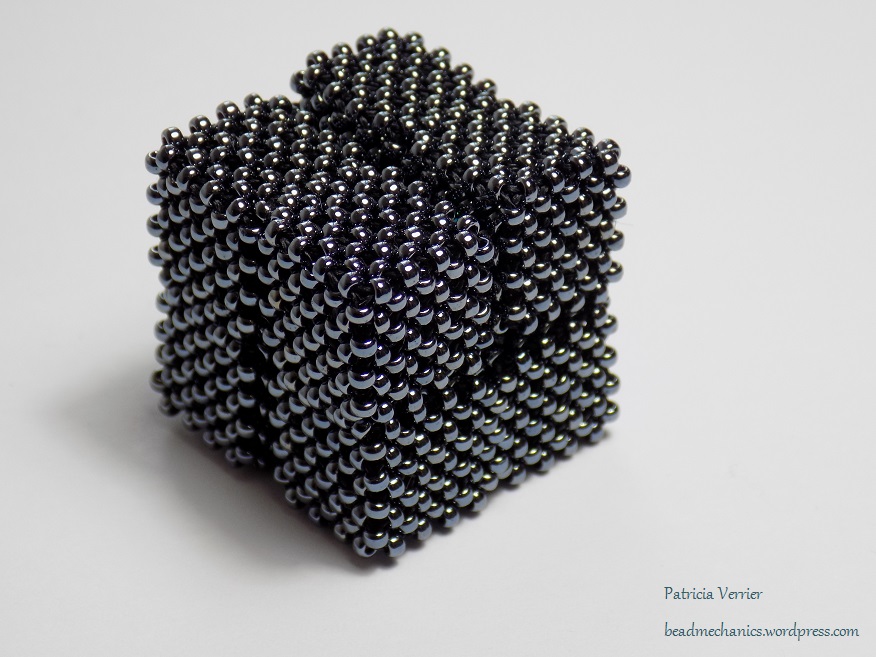UPDATE: A tutorial for this cube is available here on the blog!
So I finally managed to finish the new machine I was working on! This time it’s not a kaleidocycle but a folding cube made using cubic right angle weave. Here’s a video:
I can’t find out if these cubes have a technical name, but they seem to generally be known as magic folding cubes. They’re actually quite similar to kaleidocycles, since they’re a ring of eight linked cubes that can be rotated around back to the original starting point. However, they’re also very different since they alternately form two larger cubes during this rotation. I made the faces on each of these bigger cubes distinct – one is just the plain cubic right angle weave surface:

and the other has crystals embedded in it:

Each individual cube is a 4 by 4 block of cubic right angle weave, with a 2 by 2 gap for the crystals on three sides. Each of these cubes are joined to the two neighbouring cubes using modified right angle weave to make a hinge. I used size B nymo, size 11 seed beads and 4mm crystals (although 3mm or a flatter bead might have been better as the 4mm is just slight too big). I also found a curved beading needle a big help for some of the later rows!
If you want to try making one then I recommend making a paper model first for the hinge pattern – there are a lot of websites with instructions for making paper versions and having a model really helped a lot when I was putting it together.
Eventually I’d like to try making one out of 8 stellar octangula (a polyhedron that looks like two intersecting tetrahedra), since they have the same layout of vertices as a cube so could be fitted together in a similar way. Worked out that I’d need to make 192 triangles to do this though – might take a while!
This is wonderful. I need all the help I can get to do 3D pieces. If you post a pattern, hope you’ll let me know.
Phyllis Dintenfass http://www.phylart.com >
LikeLike
All of the rest of us too. Is this based on origami?
LikeLike
I’ve seen origami ones, but they’re a more general thing — you often get them with photos on each side or with company logos/advertising on them.
LikeLike
I’ll love the pattern if it’s available please, I love a challenge.
LikeLike
I’m going to try and put together a more detailed tutorial – hopefully it won’t take me too long!
LikeLiked by 1 person
Sooooo beautiful! Your artistry is fandamntastic ! I would also love to get the pattern!
LikeLike
Would love a pattern. Thanks
LikeLike
Hi Pat, the tutorial is here on my blog: https://beadmechanics.com/2016/11/20/folding-cube-tutorial/
Enjoy!
LikeLike
Fantastic . This Yoshimotos Cube 1, but in that it is formed of two parts so that it opens to reveal a star then the outer part can be re folded to form another star. They fascinate me.
LikeLike
Yoshimotos Cube is amazing! I thought of making something similar to just one star using CRAW by just not fully completing the inner faces – so many possibilities!
LikeLike
I’ve been trying to figure this one out also. The hinges seem tricky. I’d love to be informed of any updates. Thanks
LikeLike
If it’s where to place the hinges that is your problem , try You tube. There’s lots of info on there. If its the beading part then I can’t help you. I’m still making YC 1,2, and 3 from card. It’s strange how we can travel down the same road. I thought this was the best way to go before trying to bead them . I think I’ve figured out Number 1 but not so sure about 2 and 3 . Oh Lord give me more time.
LikeLike
Yep, youtube is a great place for help with the hinge pattern – a search for ‘Magic Cube’ or ‘Magic Photo Cube’ will find a lot of videos showing where the hinges go. As for the beaded version, I’m going to try and write up more detailed instructions this weekend, but the hinges actually turned out quite easy to make in the end.
I’ve never made a model of YC2 & 3 but they are awesome — am I right in thinking that they’re essentially kaleidocycles with different proportioned tetrahedra? It’s hard to tell from a video!
LikeLike
Yep but the frustrating thing is at the moment I can’t figure how I could bead them . The shapes vary unlike the Cube 1 and the kaleidocycle . I can’t see a stitch that would work consistently on all three. Maybe I’ll treat myself to a set of the originals. My card versions don’t let me get into easily manipulating them. Too rickety.
LikeLike
I understand that frustration – I’ve been working on a non-regular kaleidocycle and it’s surprisingly difficult to make a flat triangle with different and specific length edges. Think how amazing the set will be when you finally crack it though!
LikeLike
I looked up Yoshimotos Cube yesterday so cool!! definitely have to make a paper model to see how it works
LikeLiked by 1 person